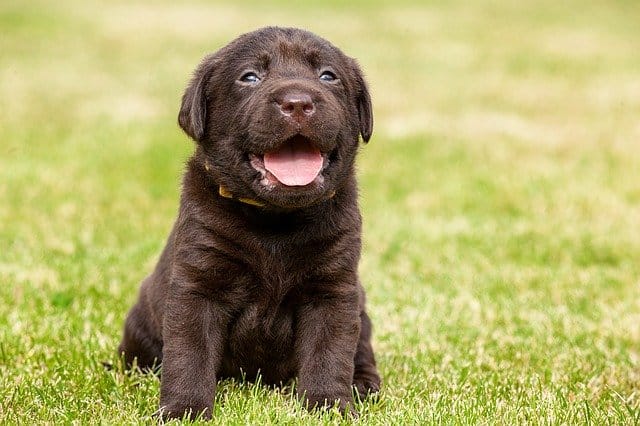If you’re out at work during the daytime, leaving your dog home alone, there’s an obvious problem. At some point during the day, your dog will need to relieve himself, especially during warm weather when he’s drinking more.
Puppies and senior dogs often can’t hold it for long, leading to accidents in the home.
It’s not always affordable or practical to pay for someone to come and take your dog out during the day, so what can you do to make your pet’s life more comfortable?
Table of Contents
Fake Dog Grass Potty Training
Fake grass potty training pads can be an excellent solution to the problem of providing your pet with a loo that he can use when you’re not around to let him outside or take him for a walk.
Artificial grass looks just like the real thing but is actually made from a kind of astroturf. Any mess that your pet leaves on the grass won’t leak through to damage the flooring beneath, and cleanup is quick and easy. All you have to do is wash the pad in warm water and clean it with pet-safe antibacterial detergent.
How To Train Your Puppy To Use Artificial Grass Potty Pads
First of all, you need to teach your puppy that it’s acceptable for him to relieve himself in your home, provided that he only does so on the artificial grass.
Of course, if you already trained your pup that the only place where he should go potty is outside in the garden, it can be difficult for your pet to understand that he can also go in the house when he needs to.
Golden Rules
Before you begin to coach your dog, there are a few important things to remember:
- Choose one location for the artificial grass and don’t move it.
- Pick a quiet place where your pup won’t be distracted.
- If possible, pick a spot that’s on a hard floor, not a carpeted area. That way, if the urine soaks through the pad, it won’t damage your carpet.
- Choose a spot that’s enclosed on three sides. That prevents your puppy from wandering off the pad and going where he shouldn’t.
- Try to find a place to put the pad that’s close to a sink, drain, or trash can for easy cleanup.
- Allow plenty of time for training sessions so that you don’t need to rush.
- Be patient. It can take your puppy a few weeks to understand the new potty regimen.
- Make sure that the pad is large enough to accommodate your puppy. He should have enough space to turn around comfortably when using the pad.
It’s important to understand that your puppy will probably become confused when you start training him to use the astroturf potty pad in the house. So, be patient, and understand that training your puppy will take some time to accomplish.
What You’ll Need:
- Your puppy’s harness and leash
- Treats to reward your pup
- Artificial grass
- A command for your puppy to “go potty”
How To Do It:
Later in this guide, we’ll discuss how to approach training an older dog to use a grass potty pad. But, first of all, let’s take a look at how to go about training a puppy.
Step 1 – Introduce Your Puppy To The Fake Grass Potty Pad
Once you’ve got the artificial grass potty pad set up where you want it, you need to introduce your puppy to his new loo.
Have your pup in his harness with his leash attached. Lead him to the pad and let him sniff it.
While your pet is exploring the pad, use your command so that the puppy learns to associate potty time with the pad.
Step 2 – Anticipate Potty Time
If you’ve already trained your pup to go outside when he needs to relieve himself, you’ll be familiar with the signs that a potty stop is imminent.
These behaviors are a giveaway that your pet needs to go:
- Puppies and even older dogs usually need to go immediately after waking up, drinking, eating, and enjoying a playtime session. So, lead your puppy to the potty pad 15 minutes or so after any of these events.
- If the pup begins sniffing the ground and ignoring his toys, that’s often a sure sign that he needs to go. Pick up the puppy and take him to the fake grass potty pad before it’s too late!
- Young puppies often need to relieve themselves every two to three hours, so be ready to take your puppy to the pad in line with that.
Step 3 – Be Quick To Reward Your Puppy
The best way to train puppies and dogs is to use positive reinforcement in the form of praise and treats. So, when your pup gets it right and relieves himself on the astroturf pad, make sure that you praise him immediately.
Pet your puppy, be excited in the tone of your voice, and give him a treat.
Step 4 – Stick To A Regular Schedule
Keeping the training consistent is absolutely essential.
So, keep the pad in the same place and take the puppy to the pad whenever you think he needs to go. Soon, the puppy will begin to anticipate and go to the fake grass pad on his own when he needs to.
How To Train An Older Dog To Use Fake Grass Potty Pads
Older dogs can also be trained to use fake grass potty pads.
That’s good news if you have a change of circumstances, meaning that you’ll need to be out all day and for senior dogs that might not be able to last as long before they need to go.
Senior dogs with incontinence issues often struggle to make it through the night without having to relieve themselves. So, providing your pet with a toilet is a great way of helping to keep him comfortable and avoiding anxiety issues.
The technique for training an older dog to use fake grass potty pads is essentially very similar to the method you’d use for training a puppy.
Step 1 – Get The Right Size
Choose the right size pad for your dog. Older dogs need much more space to turn around and squat than puppies. That’s especially true for senior dogs that might be arthritic and stiff.
Step 2 – Privacy
Older dogs, especially those from rescue centers, are more likely to use a potty pad if it’s in a quiet place where the dog can relax and has some privacy.
Step 3 – Easy Access
The potty pad must be easy for your dog to get to. Older dogs can be lazy, especially if they have joint problems that can make moving around uncomfortable. So, put the pad in a location that’s close to where the dog sleeps or plays.
Avoid putting the pad where your dog eats. Just like people, dogs prefer to have a separate area for eating and relieving themselves.
Step 4 – Introduce Your Dog To The Grass Potty Pad
Put your dog on his leash and walk him up to his new loo. Encourage the dog to have a good sniff around and explore the pad. You’ll need to do that several times a day for a few minutes.
The more familiar your dog is with the potty pad, the more likely he is to use it.
Step 5 – Be Enthusiastic!
When you take your dog to the potty pad, get enthusiastic and animated about it. If you’re excited, there’s a good chance your dog will be, too, and he’ll be more likely to use the pad.
Step 6 – Put Your Dog’s Scent On The Grass Pad
Dogs are very strongly scent-oriented, and you can use that ability to train your dog to associate the fake grass pad with toileting.
So, it can be helpful to take some grass, leaves, or soil from wherever your dog usually relieves himself outside and put that material on the fake grass pad indoors. Your dog will immediately understand that the grass pad is his toilet area and should begin to use it.
Once you’ve cleaned the pad, you won’t be able to smell anything, but your dog’s keen sense of smell will still be able to pick up his scent on the pad, and he’ll continue to associate it with going potty.
Step 7 – Routine
As mentioned above, watch out for the telltale signs that your dog needs to go to the bathroom.
As soon as you think the event is imminent, put your dog on his leash and take him to the grass pad. Encourage your pup to go but turn around or walk a few steps away so that your dog has some privacy.
Step 8 – Praise And Reward
Be ready to reward your dog with lots of praise and super-tasty treats when he gets it right and uses the pad.
Some dogs get to associate using the pad with receiving a reward, meaning that they’re more likely to go there.
Step 9 – Never Punish Your Dog!
Accidents are bound to happen from time to time, especially when you’re training an older dog. If your dog makes a mistake or you’re not around when he’s likely to need to go to the toilet, never punish your pet.
As your dog gets older, his ability to hold on will diminish. Senior dogs can develop canine dementia, and one of the symptoms of that is urinary incontinence. Punishing or scolding your pet will only serve to upset him and make him anxious, so he’s even more likely to pee out of fear.
Final Thoughts
If you have to spend part or all of your day out at work, leaving your pet home alone, fake grass potty pads can be the ideal solution for dogs of all ages.
Take care that you choose a pad that’s large enough for your pet, site the pad somewhere private and easy to access for both you and your dog, and be patient and sympathetic in your training methods.
Once your dog has learned to use his new indoor loo, life will be much more comfortable and stress-free for both of you. What a relief!

